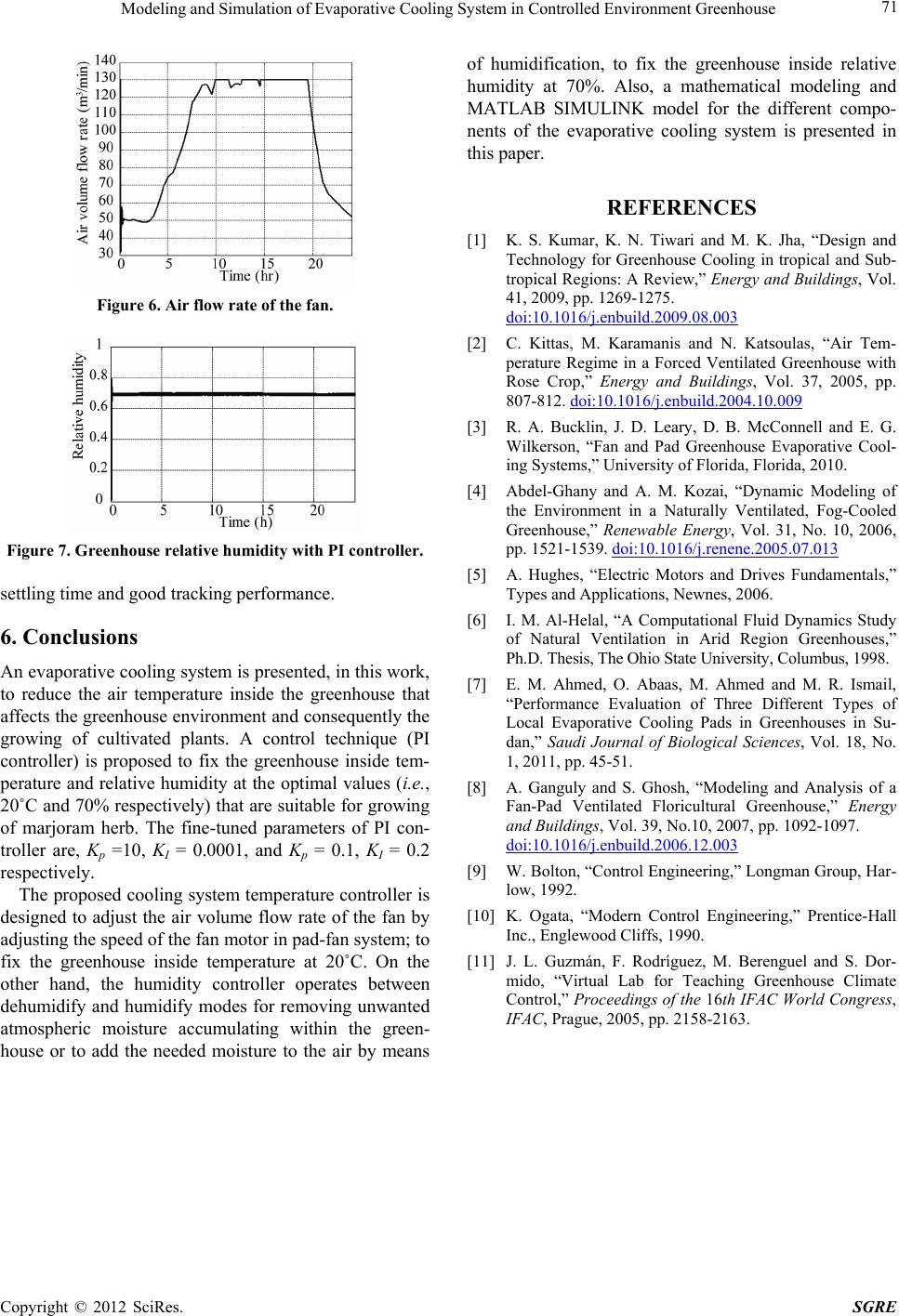
Modeling and Simulation of Evaporative Cooling System in Controlled Environment Greenhouse 71
Figure 6. Air flow rate of the fan.
Figure 7. Greenhouse relative humidity with PI controller.
settling time and good tracking performance.
6. Conclusions
An evaporative cooling system is presented, in this work,
to reduce the air temperature inside the greenhouse that
affects the greenhouse environment and consequently the
growing of cultivated plants. A control technique (PI
controller) is proposed to fix the greenhouse inside tem-
perature and relative humidity at the optimal values (i.e. ,
20˚C and 70% respectively) that are suitable for growing
of marjoram herb. The fine-tuned parameters of PI con-
troller are, Kp =10, KI = 0.0001, and Kp = 0.1, KI = 0.2
respectively.
The proposed cooling system temperature controller is
designed to adjust the air volume flow rate of the fan by
adjusting the speed of the fan motor in pad-fan system; to
fix the greenhouse inside temperature at 20˚C. On the
other hand, the humidity controller operates between
dehumidify and humidify modes for removing unwanted
atmospheric moisture accumulating within the green-
house or to add the needed moisture to the air by means
of humidification, to fix the greenhouse inside relative
humidity at 70%. Also, a mathematical modeling and
MATLAB SIMULINK model for the different compo-
nents of the evaporative cooling system is presented in
this paper.
REFERENCES
[1] K. S. Kumar, K. N. Tiwari and M. K. Jha, “Design and
Technology for Greenhouse Cooling in tropical and Sub-
tropical Regions: A Review,” Energy and Buildings, Vol.
41, 2009, pp. 1269-1275.
doi:10.1016/j.enbuild.2009.08.003
[2] C. Kittas, M. Karamanis and N. Katsoulas, “Air Tem-
perature Regime in a Forced Ventilated Greenhouse with
Rose Crop,” Energy and Buildings, Vol. 37, 2005, pp.
807-812. doi:10.1016/j.enbuild.2004.10.009
[3] R. A. Bucklin, J. D. Leary, D. B. McConnell and E. G.
Wilkerson, “Fan and Pad Greenhouse Evaporative Cool-
ing Systems,” University of Florida, Florida, 2010.
[4] Abdel-Ghany and A. M. Kozai, “Dynamic Modeling of
the Environment in a Naturally Ventilated, Fog-Cooled
Greenhouse,” Renewable Energy, Vol. 31, No. 10, 2006,
pp. 1521-1539. doi:10.1016/j.renene.2005.07.013
[5] A. Hughes, “Electric Motors and Drives Fundamentals,”
Types and Applications, Newnes, 2006.
[6] I. M. Al-Helal, “A Computational Fluid Dynamics Study
of Natural Ventilation in Arid Region Greenhouses,”
Ph.D. Thesis, The Ohio State University, Columbus, 1998.
[7] E. M. Ahmed, O. Abaas, M. Ahmed and M. R. Ismail,
“Performance Evaluation of Three Different Types of
Local Evaporative Cooling Pads in Greenhouses in Su-
dan,” Saudi Journal of Biological Sciences, Vol. 18, No.
1, 2011, pp. 45-51.
[8] A. Ganguly and S. Ghosh, “Modeling and Analysis of a
Fan-Pad Ventilated Floricultural Greenhouse,” Energy
and Buildings, Vol. 39, No.10, 2007, pp. 1092-1097.
doi:10.1016/j.enbuild.2006.12.003
[9] W. Bolton, “Control Engineering,” Longman Group, Har-
low, 1992.
[10] K. Ogata, “Modern Control Engineering,” Prentice-Hall
Inc., Englewood Cliffs, 1990.
[11] J. L. Guzmán, F. Rodríguez, M. Berenguel and S. Dor-
mido, “Virtual Lab for Teaching Greenhouse Climate
Control,” Proceedings of the 16th IFAC World Congress,
IFAC, Prague, 2005, pp. 2158-2163.
Copyright © 2012 SciRes. SGRE